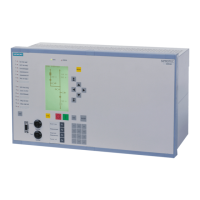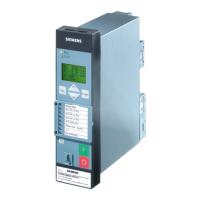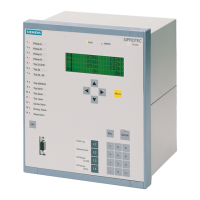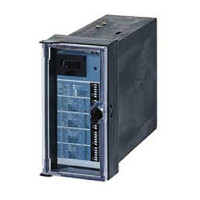General
The settings associated with the various device functions can be modified using the operating or service inter-
face in DIGSI in conjunction with a personal computer. Some parameters can also be changed using the
controls on the front panel of the device. The procedure is described in detail in the SIPROTEC System Descrip-
tion /1/ SIPROTEC 4 System Description.
Functional Scope
The 7SJ62/64 relay contains protection functions as well as auxiliary functions. The hardware and firmware is
designed for this scope of functions. Additionally, the control functions can be matched to the system require-
ments. Individual functions can be enabled or disabled during the configuration procedure. The interaction of
functions may also be modified.
Description
Setting the Functional Scope
Example for the configuration of the functional scope:
A protected system consists of overhead lines and underground cables. Since automatic reclosing is only
needed for the overhead lines, the automatic reclosing function is not configured or “disabled” for the relays
protecting the underground cables.
The available protection and additional functions can be configured as Enabled or Disabled. For individual
functions, a choice between several alternatives may be possible, as described below.
Functions configured as Disabled are not processed by the 7SJ62/64. There are no messages and corre-
sponding settings (functions, limit values) queried during configuration.
NOTE
Available functions and default settings are depending on the order variant of the relay (see A Ordering
Information and Accessories).
Setting Notes
Setting the Functional Scope
Configuration settings can be entered using a PC and the software program DIGSI and transferred via the front
serial port or the rear service interface of the device. The operation via DIGSI is explained in the SIPROTEC 4
System Description.
For changing configuration parameters in the device, password no.7 is required (for parameter set). Without
the password, the settings can be read but not modified and transmitted to the device.
The functional scope with the available options is set in the Functional Scope dialog box to match plant
requirements.
Special Features
Most settings are self-explanatory. The special features are described below.
If you want to use the setting group change function, set address 103 Grp Chge OPTION to Enabled.
Simple and fast changeover between up to four different setting groups is possible in service. Only one setting
group can be selected and used if this option is Disabled.
For the overcurrent elements of the time overcurrent protection (separately for phase currents and ground
current), various tripping characteristics can be selected at address 112 Charac. Phase and 113 Charac.
Ground. If only the definite characteristic is desired, then Definite Time should be selected. Additionally,
depending on the version ordered, various inverse time characteristic, based on either IEC (TOC IEC) stand-
ards or ANSI (TOC ANSI standards), or user-defined characteristic are available for selection. The dropout
behaviour of the IEC and ANSI characteristic will be specified later with settings (addresses 1210 and 1310).
2.1
2.1.1
2.1.1.1
2.1.1.2
Functions
2.1 General
32 SIPROTEC 4, 7SJ62/64, Manual
C53000-G1140-C207-8, Edition 08.2016

